The Battle of Savo Island
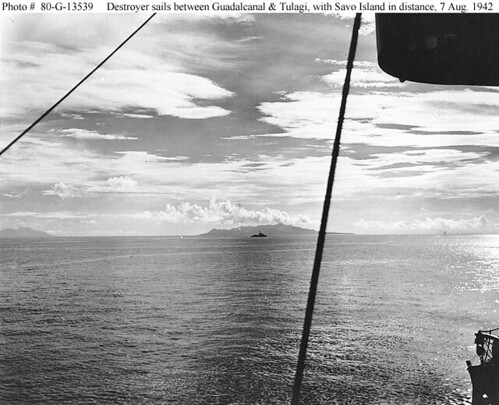
This was a huge intelligence failure on both sides (
Forces:
Prelude: IJN COMEIGHTFLT VADM Mikawa out of Rabul had at his disposal CA Chokai at 13,000 tones with 10 203mm guns and 24 torpedo tubes (we covered the joy of the “Long Lance” torpedo
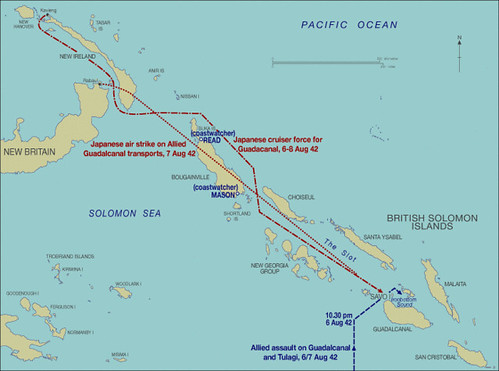
Waiting for them were parts of VADM Fletcher, RADM Crutchley (RN attached to the RAN) and RADM Turner’s forces. Overall they had a force of 3 Carriers (CV) with 140 planes, 1 Battleship (BB), 14 Cruisers (CA/L), 31 DD, 5 Oilers, and 19 Transports conducting a not-very-efficient landing. Arrayed around Savo Island’s approaches though, they had 6 CA, 2 CL, and 8 DD.
TF64 RADM Scott had the Eastern approaches with CL USS San Juan, CL HMAS Hobart, DD USS Monssen, DD USS Buchanan.
Western approaches were covered by DD Blue and Ralph Talbot.
Northern approaches under TG62.3 under CAPT Riefkohl with CA USS Vincennes, Astoria, and Quincy. Also DD USS Wilson and Helm.
Southern approaches under TG62.2 RADM Crutchley, RN had CA HMAS Australia, Canberra, and USS Chicago with DD USS Patterson and Bagley.
That’s the chessboard.

Not everything is at is seemed. Numbers don’t mean everything. The Japanese were coming south with a complete Cruiser division that had extensive training together, with a focus on fighting at night, and were rightly confident with their ample supply of the “Long Lance.” At 1430 on 07 AUG VADM Mikawa got underway with a goal to be at Savo Island on 0001 on 09 AUG. Intel (got to love the N2 folks) told him there was no danger to him from the US carriers (worked out that way, but if the US was on his toes, the Admiral would have had 140 carrier planes to worry about).
Speaking of the N2 folks, on the US side the reconnaissance plan had about everything in The Solomons covered…except….”The Slot.” Admiral Turner actually say this glaring mistake and directed that gap be filled, but due to the Byzantine chain-of-command from the Task Force-SOWESPACCOM-COMAIRSOPAC, it never took place. The afternoon of the 8th, a RAAF Hudson sighted the Japanese surface group, but by the report found its way to the Allied forces, it was reported as “3 Cruisers, 2 gunboats, and 2 seaplane tenders." This was quickly dismissed as not threat.
Here is another lesson; don’t take all intel reports, especially single first ones, at face value. Also, the Allied forces staff evaluated what the Japanese “would do” with their force, not what they “could do.”
Not seeing a threat, Admiral Turner called a meeting to go over plans as the landing at Guadalcanal was not (shock) going as planned. To make the meeting, RADM Crutchley left his TG with the CO of USS Chicago. The main force was without a Flag.
Thus the evening of 08 AUG, The Ignorant met the Ill-briefed.
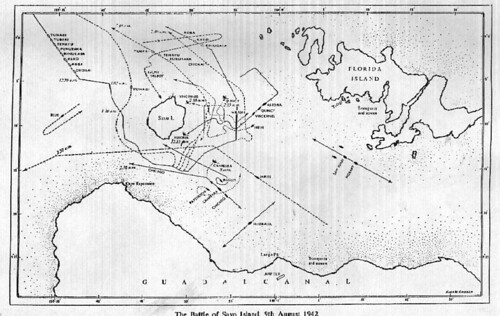
Two days of Condition ONE watches had the Allied ships exhausted. The afternoon of 08 AUG (I think) they shifted to Condition TWO, so the “A Team” could send their exhausted tails to the rack after two days of coffee driven watches.
09AUG
0047: Mikawa saw Savo Island. With his ships at 22KTS, he slipped pass Blue at 10,000 yards unseen.
0130: Increased speed to 30KTS. Northern and Southern groups sited.
0131: First “Long Lance” fired.
The rest was a slaughter.
…the eerie silence over the sound was broken by the rolling thunder of Chokai's first eight-inch volley, aimed at Canberra.
On the latter, the sudden shock of gunfire from the north brought the bridge watch into action and Captain Getting to the bridge, but her engagement that night would be swift and violent. Turning northeast to unmask her aft batteries, Canberra was hit some twenty plus times in a matter of five minutes, lost power for her armament and pumps, and was rendered unable to fight with not a single main gun round fired. A single torpedo, fired by the destroyer Bagley, had also hit Canberra.
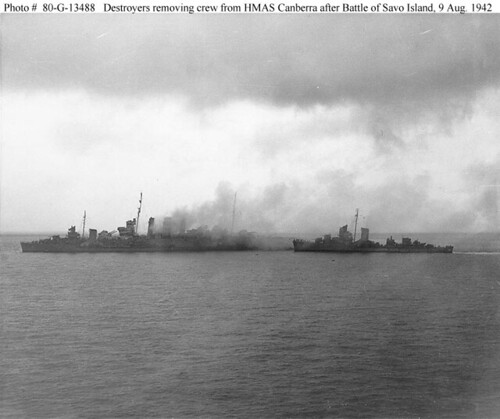
Never even returned fire. Even hit by friendly fire.
Now, I want everyone here to put yourself in the shoes of the unnamed XO of the USS Chicago. Odds are you are somewhere either on the bridge, walking around the ship. Though you have had little sleep in the last 2 days, you have to have your best watch teams resting now that you are in Condition TWO and do whatever you can as your CO is the TG Commander while the Limey Admiral is away getting facetime…
On Chicago, hints at the presence of enemy ships had been seen earlier but not triggered a response. Captain Bode, in tactical command, was in his cabin, and hurried up. Even as aircraft flares blossomed over the Southern Group, and Canberra started her turn, few on Chicago figured out the facts. Chicago did not get to fire her 203mm guns either, when she began a series of maneuvers undertaken to evade torpedoes. Alas, confusion reigned on her bridge. Captain Bode, who had come up from his cabin, reports came in of torpedoes approaching from starboard. Bode turned his vessel towards that direction, leading his to comb the Japanese torpedo spread. However, moments later, the bridge lookouts spotted torpedoes to port, from on the unengaged side, possibly from the same spread of Bagley that had hit Canberra. Bode swung his ship around again, trying to comb the new thread, but by doing so, exposed the entire length of his ship to the Japanese torpedoes. One slammed in Chicago, crippling her. Slowly, she swung westward (via a southerly heading), out of the battle. Captain Bode, immersed in the plight of his ship, and fighting the damages incurred, ignored his role as task group commander and failed to issue orders to his ships or to inform his superiors of what had happened. Chicago shortly rendered fire support to the destroyer Patterson, which was dueling with Japanese light cruisers Yubari and Tenryu. From Patterson, the only contact report had been made by the Southern Group, issued by Commander Frank Walker via radio at 0146.….or be a Gunner's Mate on the Patterson….
Mikawa could allow himself a moment of pleasure when at 0150 the searchlights of three Japanese cruisers snapped on to light the U.S. line up. A moment later, the first salvo left Chokai's gun tubes, and soon the entire Japanese line was firing, with torpedoes added for good measure.The Allied navies stood around in shock.
On the U.S. ships, disbelief was the common reaction to the sudden illumination. Captains Riefkohl and Greenman (of Astoria) were certain they faced the Southern Group, accidently assuming their Allies to be the enemy. Soon, however, shells erased all hope that a peaceful conclusion could be found with a radio call or flag hoisting (although Riefkohl tried the latter with curious success lasting several minutes). Riefkohl ordered battle stations and twenty knots, the latter being made impossible by untimely interference from a torpedo from Chokai.
Neither of the three heavy cruisers put up much of a fight, though two salvoes from Quincy slammed into Chokai, destroying a gun turret.
… not later than 0220 that all three U.S. cruisers were reduced to swimming wrecks. There remained little to do for Mikawa, who kept to a new northwest course he had established during the brief engagement with the Northern Force. There, U.S. picket destroyer Ralph Talbot blundered into the Japanese path and was given an unhealthly large dose of fire. Burning and lisiting, only a rain squall at the right time saved the little ship from becoming another victim of Mikawa's. The Admiral, after consulting his staff,decided at shortly before three in the morning to cancel any further attacks and retire at top speed to Rabaul.
Vincennes had slipped under at 0300 already … Thirty minutes past midday, Astoria accompanied Vincennes and Quincy, having already sunk at 0238, down to the ground of Ironbottom Sound.
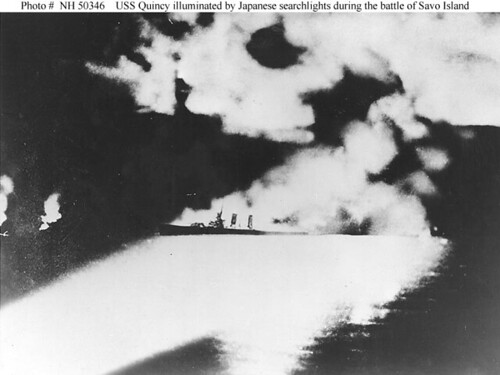
I can’t do much better than
There is, however, much more blame to spread around than could possibly be laid upon the commanders on the spot. The Allied operations plan was poor. Although the distribution of the forces could not be helped, the fact that there were only two flag officers with the three screening groups necessarily led to command problems. Captain Bode of Chicago can not be considered ill-suited for a task group command, but to control damage control efforts on his ship, designated a new course and general approach to the action for his vessel, worrying about torpedoes and the like, in addition to trying to control the rest of his force proved too much. The dogged skill of the Japanese torpedo men and gunners and the coolness of the Japanese approach added to the completeness of the victory by ascertaining that the initial blows would come out of the dark and be deadly at the same time. The engagement with the Southern Force had been decided in five minutes, and not much more time was needed to deal with the Northern Force, which had a slight advantage of strength, position and alertness over its southern counterpart. This combination of near flawless execution of a well-exercised operation by the Japanese, and the problematic layout of command and control arrangements on the Allied side led to the defeat of Savo; the worst naval defeat ever suffered by the U.S. Navy.
The









1 comment:
My Great Uncle was on (BB-44) the back of the Boat in Jan 45.
Post a Comment